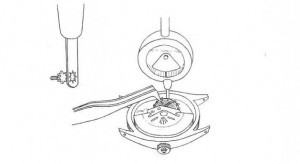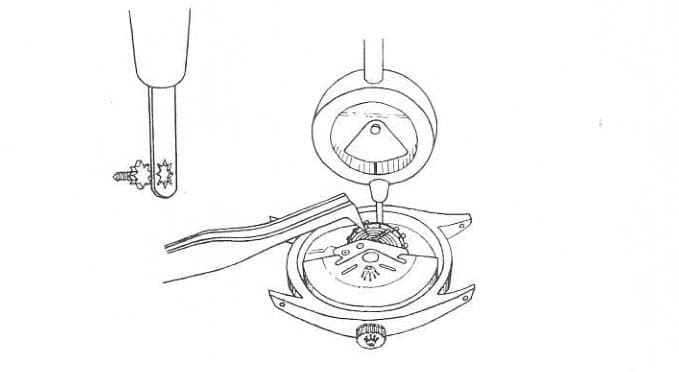Rolex Regulating Systems
Micro-Stella
-
This system is used in all 12½” Rolex chronometers of 18,000 and 19,000 beat. The balance wheel is fitted with 18 screws including tow regulating screws with slotted heads for timing adjustments when the movement is uncased.
-
Two gold Micro-Stella (star-shaped) regulating screws are provided for timing adjustment when the watch is cased.
-
The Micro-Stella wrench is comparable to a ring spanner, the tip of which fits over the Micro-Stella regulating screws on the balance wheel.
-
When performing corrections, hold balance wheel with nickel tweezers, insert the Micro-Stella tool over the screw head and screw or unscrew each one of the two Micro-Stella screws exactly the same number of degrees.
-
The Micro-Stella wrench is provided with graduations corresponding to one second each.
-
Micro-Stella wrenches are available from the Rolex Material Division.

Calibre 1400 6” Round
Because of the small size of the movement the Micro-Stella wrench cannot be used with calibre 1400 even though the basic timing principle is the same.
The balance wheel has two pairs of screws that are used for the timing of the movement. The turning of the screws is done with a fine screwdriver blade and one-quarter of one turn on one pair of diametrically-opposed screws will create a vibration of about 15 seconds per 24 hours. It is possible to make corrections of up to three minutes per day by turning the timing screws.
Timing differences greater than three minutes per day must first be corrected by using timing washers in the conventional manner.
Inertia Blocks
Calibre 1520 12½” self-winding and calibre 1600 9¼” manual-wind follow a different principle.
These movements are equipped with screwless balance wheels and flat hairsprings. The balance wheel arm is fitted with two inertia blocks for fine timing. This is done by turning these two inertia blocks (one yellow, one white) using a very fine blade, such as is used for turning the collet of hairsprings. By directing the inertia blocks splits towards the center of the balance wheel a slow-down is obtained; while a gain of time will result if the splits are turned in the opposite way. The maximum correction obtainable is approximately 10 seconds per 24 hours, from one extreme position to the other. More substantial corrections are done by moving the regulator.






